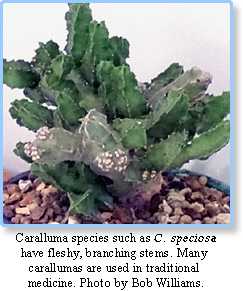Caralluma (2017)
By Bob Williams (June 2017)
 At the Mid-States Cactus and Succulent Conference last June, there was a plant in flower that caught my eye. The plant had a clump of small flowers that were dark red. They were small, maybe one-quarter inch in diameter. Each clump had 20 to 30 flowers.
At the Mid-States Cactus and Succulent Conference last June, there was a plant in flower that caught my eye. The plant had a clump of small flowers that were dark red. They were small, maybe one-quarter inch in diameter. Each clump had 20 to 30 flowers.
After passing it by, on the third day, Caralluma speciosa finally called my name. As I was showing it around, everyone was commenting on the smell. I didn’t notice anything, though. When I was putting plants in my car at Leo Chance’s house for other members, the comments continued. My article last month was about stapelias and their unique odor, and I now have a companion plant.
Caralluma is a genus found in the Apocynaceae family, and the group is a close relative of stapelias. Both are considered part of the milkweed family. The generic name is derived from the Arabic word qahr al-luhum, meaning “wound in the flesh” or “abscess,” referring to the odor. Depending on the source, there are anywhere from 100 to 250 species within this genus.
Carallumas are native to the desert regions of East Africa, the Arabian Peninsula eastward to the desert regions of India and Afghanistan. They grow in clumps that can reach 2 to 3 feet in diameter and 12 inches tall. These plants like their summers hot and sunny. The four-sided stems are fleshy and stiff. Unlike stapelias, which send out stems from the base, a caralluma can branch at the base or anywhere up the stem of the plant.
Carallumas are grown for their tight clumps and their flowers. The flowers have five points. Most of the individual flowers are very small: one-quarter to one-half inch across. They bloom in clumps of 20 or more in late summer and early fall. The most common flower colors are black, purple, yellow, brown, maroon and red.
 The distinct odor of carallumas attracts the blow fly, the main pollinator of these plants. When the seed pods open, the seeds have the same white feathery “parachute” as the common milkweed, and they are dispersed by the wind.
The distinct odor of carallumas attracts the blow fly, the main pollinator of these plants. When the seed pods open, the seeds have the same white feathery “parachute” as the common milkweed, and they are dispersed by the wind.
Carallumas have nutritional and medicinal value. In India, C. edulis is eaten raw as a green. C. adscendens is another species eaten in rural India as a vegetable with spices, or preserved in chutneys and pickles. Larger plants are often found as a roadside shrub or boundary marker.
Carallumas have been used as a portable food and thirst quencher for hunting. Tribesmen on a day’s hunt will often pack only some C. fimbriata to sustain themselves. The plants are commonly known as “famine food” in India.
Many species of Caralluma are used as traditional medicine for the treatment of rheumatism, diabetes, leprosy, paralysis and inflammation. C. fimbriata is most commonly used as a diet supplement.
Carallumas are easy to grow in the summer, but seem to be hard to overwinter. They need a very well-draining soil mix and do better in clay pots than in glazed ones. They can take a good soaking during hot summers and can handle high temperatures, but not cold. In winter, they should be in a room that stays above 50 degrees F. Watering should be slowed down during the winter, but not eliminated. A small amount every three weeks works.
From my research, it appears carallumas are best bought from vendors. Trying to propagate with root cuttings seems to be very tricky, with rot an issue. Little information is available on growing from seed. Wooly aphids and mealy bugs find these plants a favorite source of nourishment, so frequent inspections should be done.
There are a few varieties available on the Internet. Arid Lands has a few species for sale. I also found that Living Stones Nursery had some for sale, but the company is changing its online store, so I don’t know what is currently available.
